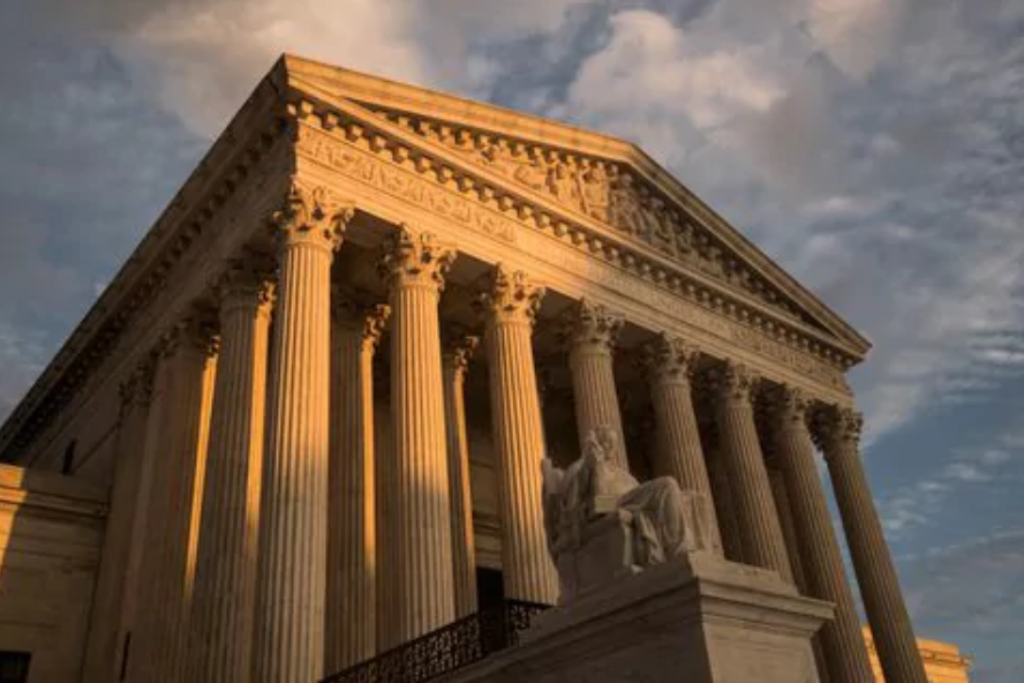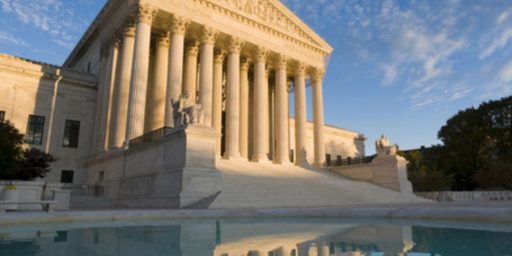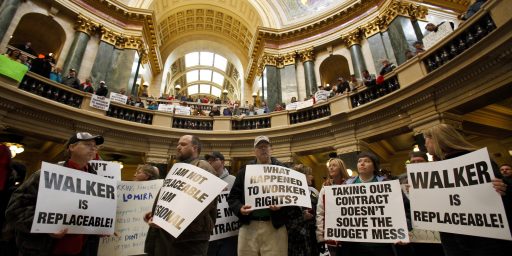Supreme Court Sides with Company Over Teamster Vandals
Dueling headlines give radically different impressions of the same case.

Reuters (“US Supreme Court hands defeat to organized labor in truckers strike case“):
The U.S. Supreme Court on Thursday dealt another setback to organized labor by making it easier for employers to sue over strikes that cause property destruction in a ruling siding with a concrete business in Washington state that sued the union representing its truck drivers after a work stoppage.
The 8-1 decision overturned a lower court’s ruling that said the lawsuit filed by Glacier Northwest Inc, which sells and delivers ready-mix concrete, against a local affiliate of the International Brotherhood of Teamsters was preempted by a U.S. law called the National Labor Relations Act. Glacier Northwest is a unit of Japan-based Taiheiyo Cement Corp.
Glacier Northwest filed a lawsuit in Washington state court accusing the union of intentional property destruction during a 2017 strike.
A group of drivers went on strike while their mixing trucks were filled with concrete. Although the drivers kept their mixing drums rotating to delay the concrete from hardening and damaging the vehicles, the company was forced to discard the unused product at a financial loss.
The Washington state Supreme Court in 2021 ruled that the company’s claims were preempted by a statute called the National Labor Relations Act (NLRA), saying the company’s loss of concrete was incidental to a strike that could be considered arguably protected under federal labor law.
Conservative Justice Amy Coney Barrett, who wrote the ruling, said the union’s actions had not only destroyed the concrete but had also “posed a risk of foreseeable, aggravated and imminent harm to Glacier’s trucks.”
“Because the union took affirmative steps to endanger Glacier’s property rather than reasonable precautions to mitigate that risk, the NLRA does not arguably protect its conduct,” Barrett wrote.
Liberal Justice Ketanji Brown Jackson, in a 27-page dissent, wrote that the ruling “is likely to cause considerable confusion among the lower courts” about how preemption under the National Labor Relations Act should apply in future cases and “risks erosion of the right to strike.”
The Supreme Court, with its 6-3 conservative majority, has leaned toward curbing the power of labor unions in rulings in recent years.
The justices in 2021 struck down a California agricultural regulation aimed at helping unions organize workers. The court in 2018 ruled that non-members cannot be forced, as they are in certain states, to pay fees to unions representing public employees such as police and teachers that negotiate collective bargaining agreements with employers.
Noel Francisco, the lawyer who represented Glacier Northwest in the case decided on Thursday, said the ruling “vindicates the longstanding principle that federal law does not shield labor unions from tort liability when they intentionally destroy an employer’s property.”
Teamsters General President Sean O’Brien said the Supreme Court had “again voted in favor of corporations over working people.”
NPR, though, gives an entirely different impression of the ruling (“Unions are relieved as the Supreme Court leaves the right to strike intact“):
The U.S. Supreme Court on Thursday handed a victory to business interests in a labor dispute, but the win was more of a whimper than a roar.
By an 8-to-1 vote, the high court ruled against unionized truck drivers who walked off the job, leaving their trucks loaded with wet concrete, but it preserved the rights of workers to time their strikes for maximum effect.
“Virtually every strike is based on timing that will hurt the employer,” said Stanford Law School professor William Gould, a former chairman of the National Labor Relations Board, and there was “great concern that the court would rule broadly to limit the rights of strikers. “But that didn’t happen,” he noted in an interview with NPR.
At first glance, the Supreme Court did seem poised to issue a decision more damaging to unions. Thursday’s ruling followed three earlier decisions against labor in the last five years, including one that reversed a 40-year-old precedent. And the truckers’ case posed the possibility that the court would overturn another longstanding precedent dating back nearly 70 years. So labor feared the worst: a decision that would hollow out the right to strike. Thursday’s decision, however, was a narrow ruling that generally left strike protections intact.
[…]
The company sued the union in state court, claiming the truck drivers had endangered company equipment. Wet concrete, it explained, hardens easily, and the company had to initiate emergency maneuvers to offload the concrete before it destroyed the trucks.
But the Washington Supreme Court ruled that Glacier’s complaint should have been filed with the National Labor Relations Board. For nearly 70 years, the Supreme Court has said that federal law gives the Board the authority to decide labor disputes as long as the conduct is even arguably protected or prohibited under the federal labor law.
The business community was gunning for, and hoping to eliminate, that rule. But it didn’t get its way. This was a case of winning a relatively minor battle but losing the war. The high court did not overturn or otherwise disturb its longstanding rule giving the NLRB broad authority in labor disputes, leaving unions free to time when they will strike.
At the same time, the court’s majority decided the case in favor of the company in a very fact specific way. The court ultimately said the union’s conduct in this particular case posed a serious and foreseeable risk of harm to Glacier’s trucks, and because of this intentional harm, the case should not have been dismissed by the state supreme court.
Writing for a conservative/liberal majority, Justice Amy Coney Barrett was joined by Chief Justice John Roberts and Justices Brett Kavanaugh, Sonia Sotomayor and Elena Kagan.
Justices Samuel Alito, Neil Gorsuch, and Clarence Thomas, the court’s three most conservative justices, wrote separately to express frustrations that the court did not go further and reverse a lot of the protections for striker rights. Justice Alito virtually invited Glacier or other business interests to come back and try again.
Writing for the dissent, Justice Ketanji Brown Jackson argued the union acted lawfully in timing its strike to put maximum pressure on the employer, pointing out that Glacier could have locked out the workers, or had non-union workers on standby in the event of a strike to prevent any surprise strike timing.
On the facts, Jackson’s dissent is just bizarre. The notion that, by continuing to let union employees continue working under an expired contract while negotiations continued, the company was asking for them to destroy their equipment out of spite is absurd. Of course the union should be liable for the ensuing damages—which the company mitigated considerably by dumping the concrete before it hardened.
I don’t have a firm enough grounding in labor law to have a firm opinion on the deference to the Garmon precedent, other than the fact that 1959 was a long time ago and it should be presumed to be settled law at this point. Further, since neither of the litigants sought to overturn the precedent, it would have been unusual—dare I say, activist—to do so here. Indeed, contra Nina Totenberg’s reporting, I see nothing in either the Thomas or Alito concurrences that even remotely hinted at taking away the right to strike or, indeed, to time strikes for maximum leverage.






Thanks for posting this, Dr. Joyner. I read the two headlines (next to each other on Memorandum) yesterday, and was flummoxed that they were discussing the same case with such disparate headlines.
I’m very pro-union, but this strikes me as a case that should have been 9-0. Jackson’s dissent makes no sense. You can’t give union members the right to destroy company property without impunity as a condition of “The Right to Strike.”
I haven’t read Jackson’s dissent, but I don’t get it either. The right to strike is NOT being infringed.
I’m pro-union.
This decision is correct, and Jackson is wrong.
In addition…any tradesman who would intentionally damage equipment should have been fired for cause as soon as the strike was over.
That seems like activist judging. I wonder if we’ll ever find out who plays the role of Harlan Crow as handlers of Alito and the other Federalists.
I wonder, if the pilots for an airline were to strike one fine morning, after the first flights of the day at the major hubs have begun boarding, could the airline sue the union for lost revenue?
While I think the majority got it right in terms of justice, it remains to be seen if the decision makes things clearer or more nebulous. Where is the dividing line? This case lies at one extreme. But what about people who work in food plants? What if food spoils when they don’t show up for work? What if the raw ingredients spoil because they were en route to the facility and had to be diverted?
A good ruling lends clarity to where the dividing lines are, whereas a poor one opens up a thousand new avenues for litigation. At this point I have very little confidence in any of the members of this court, regardless of political leanings. They seem completely disconnected from the real world and live ins some sort of airy-fairy alternate reality where interacting with the real world consists of special two week “teaching” gigs in luxury locals with all travel and accommodations paid for and every evening packed with wonderful cocktail hours and dinners with just thr widest variety of very wealthy and influential people.
The Supreme Court has become like a major league sports team, where the future “players” are groomed from a young age in the potential superstar track, and the ones who make it end up living a very narrow and focused life. There is no denying they work very hard to achieve that position, again, like major league stars, but unlike those stars they are expected to rule on minimum wage working conditions, and low level careers ended because of casual bigotry, power disparities, and what “access” to healthcare means to a poor temp worker in Oklahoma. They couldn’t have less lived experience in any of this, at least as adults.
BTW, in pieces I’ve read about it, the salient practical issue is that employees left the trucks full of cement when they struck.
In an old Mythbusters ep, they did just that with one truck, to test he myth it could be cleaned with a stick of dynamite. Spoiler alert: not even close.
A truck with a full load left to dry is ruined. At least the rotating drum needs to be replaced. Explosives won’t clear the dried cement without damaging the drum. Even using a jackhammer to break it up proved it would take a long time, and it was hell on the person tasked with the attempt.
It didn’t work when they tried to leave a thin layer of dried cement covering the inside of the drum, either. Though that could be removed without ruining the drum.
Then they blew up a cement truck for the visuals, because that’s the kind of show it was (I miss it a lot).
@Kathy: They left the trucks rotating so the cement didn’t set. The supervisors had to dump the cement before it set as they didn’t have drivers to make the deliveries. The damages were for the cost of the cement, not the trucks. If it was the trucks I don’t think it would have made it very far as there is ample precedent that deliberate sabotage is actionable.
This is why I think the wording and the surrounding case law is going to prove important. The Justices attempted to leave in place the concept that workers are allowed to select their moment to strike while ruling against them in this particular case. The whole point of a strike is to cost the employer money and therefore demonstrate how much they need you. But in trying to say “you can pick a time that costs the most money, but just not THIS time,” it risks opening up a whole slew of cases if “THIS” isn’t clearly defined.
From the Reuters article quoted above,
Brings back fond memories. Back when I worked warehousing, companies had their back-up drivers on call about a week before a strike would happen. And hiring drivers is precarious business. The last driver strike I recall back in my day, Allied Employers companies (about 20 companies total) were said to have paid out one million dollars in property damage claims on the first day deliveries were done by scab drivers. Fun times.
@MarkedMan:
The question before the court was not “did the union do something wrong?” it was “Can they be sued?” There is no dividing line. It’s a simple “yes”. Whether the union is liable for damages is something for the jury to determine.
Cement cures. It’s a chemical reaction, and leaving the trucks rotating will only delay the process, not prevent it. They could have struck before loading for the day. Instead they did it at a time that had the highest potential for damaging the trucks–and they knew the loads had to be dumped–and quickly (90 minutes seems to be the default).
This was an intentional act of sabotage. It’s as if they went to a food warehouse, loaded up the trucks, and then dumped the loads into a river.
@Mu Yixiao: I think your comparison is a touch hyperbolic, but to each his own. The fact that the cement has a window makes the argument for Jackson’s “shoulda had replacement drivers ready to go” position wiser than “we’ll just blame them for the loss.” Again, though, to each his own and people should probably consider themselves lucky that they have jobs at all in our new emerging gilded age.
@Mu Yixiao: As I read the articles the drivers drove all the trucks over to be filled and only then went on strike. At that point management couldn’t find anyone available with the appropriate license and experience to deliver it, so they had to dump it. No trucks were harmed, and you can only sue for actual damages, not “might have” damages, so they sued for the cost of the cement they dumped.
This is a tricky case, as I said above. In the past it has been clearly accepted that striking workers were not responsible for losses their employers incurred simply because they went on strike, even if the strike was timed to inflict maximum financial pain. I don’t know why the Supremes accepted this case but what they have attempted to do in the ruling is to say, “inflicting maximum financial pain is OK, unless you go too far by doing X”. We will know how well they defined “X” by how many cases come up over the next 5-10 years. I don’t have a lot of confidence in their ability to split hairs anymore.
What are the facts? Because of the procedural posture in which this case came to the Supreme Court we don’t know what the facts are. We only know what facts Glacier Northwest alleged. Neither you, nor I, nor anyone else reading the opinions can know the extent to which Glacier Northwest will be able to prove those facts.
How, then, should those facts be proven? The whole point of Jackson’s dissent is that Congress created the NLRB as an agency with specialized expertise to decide whether or not particular actions are protected labor activity, and to make the factual determinations necessary to reach such a decision. If the actions are protected, they cannot be grounds for a lawsuit in state court. If, on the other hand, the NLRB finds that they are not protected such a lawsuit can proceed after, but only after, the NLRB has made that finding. Jackson’s dissent did not say it’s fine for striking union members to destroy their employer’s property. She made the much more limited argument that the rule is that the initial decision as to whether that’s happening is to be made by the NLRB, not by whichever state court judge the employer can get its case in front of.
The reason for such a rule is not hard to understand. We have in this country a history going back at least a century and a half of local courts siding with business against labor. The ability to file this kind of action in state court rather than the NLRB risks inconsistent holdings throughout the country as to what is or is not protected labor activity, with unions having to deal with being dragged into court any time management decides they’ve gone too far. And the history of management in the U.S. is that they always believe that labor has gone too far.
It’s reasonable to think that Jackson’s wrong. I don’t think that, but I see how a reasonable person could disagree with me about that. But it is (I don’t know of a better word for it) bizarre to think that her opinion was bizarre.
@Mu Yixiao:
Wait, that was not the question before the court. Of course they could be sued. They WERE sued. No one is arguing that. What the Supremes were ruling on was whether the union is liable for damages hinges under the law. And the relevant law?
The questions before the Supremes was, 1) did the strikers action fall under that statute , 2) is the statute constitutional, 3) how should the statute apply to this case.
To you it might seem like it’s easy, but to me it seems like it is a very difficult thing to define in such a way as to provide clear guidance for lower court judges handling future cases. I guess we will know if a few years by how many cases make their way up the appeals process.
(For what it’s worth, I think justice was served by the decision, but justice can be served by a bad decision as well as a good one. The question is whether the legal system will be well served by this decision and that, rather than justice, is the purview of the Supreme Court.)
@Roger: Very well said. I’m glad the thumb is back
@Roger: I see the rationale for thinking the decision bizarre. For conservatives, most any situation that goes against the rights of the owner of property seems bizarre. In this case, I think that Jackson is right on the issue that the NLRB is the venue that has the experience to decide, but certainly conservatives will think the ruling bizarre corresponding to their belief that the company won’t prevail at NLRB.
@Roger:
Usually on an 8-1 decision, the 1 is wrong on the facts and the law. In this case, even more so.
@just nutha: I’m nowhere near a conservative, and find her ruling bizarre and unfounded , based on the law
@EddieInCA: FWIW, I can’t understand why you find it bizarre. Wrong, maybe, (I don’t have enough expertise to judge that) but bizarre? What about it do you think is so strange?
(I know you are in film and TV production and I believe that means interacting with Teamsters and their Reps? My experience comes from getting trade show equipment in and out of places like the Javits center in NYC. I’m pro-union but from history we know the Teamsters’ management has often been interchangeable with the Mob, and from my experience the individual members would be very comfortable working either side of that divide themselves. So anytime someone sides with the Teamsters it is bizarre in at least one respect.)
Two points:
1.) How attenuated does the damage have to be? Supposed the teamsters had never showed up to their shifts to begin with and thus the concrete was mixed, but there was no trucks waiting to put it in. Are they responsible for that? Suppose it was an SEIU strike at a Starbucks and the food that would otherwise have been served to customers over the course of a week expires in the refrigerator. Are they responsible for that? Suppose a big customer decides to switch to another company because of the strike and they lose sales. Is the union responsible for that? What’s the line now?
2.) Much more importantly, even if we accept, arguendo, that this was an illegal strike, for 70 years the precedent has been that the determination of what is and isn’t an illegal strike is made by the NRLB, not the courts, specifically to prevent a strike analogue to a SLAPP lawsuit where corporations use costly litigation to punish unions for exercising their rights. Thanks to this ruling, we’re going to see basically every union get sued every time there’s a strike, just to drain their funds.
@Stormy Dragon:
What’s the distinction between the Glacier case and:
Workers at a Wisconsin hospital sought new jobs with higher pay — then the hospital sued to stop them from leaving
Without a clear line as to when costs are more than incidental, I think this is a terrible ruling, and side with Justice Jackson.
Most strikes are going to result in some damage — food spoilage, unmet deliveries, etc. This opens up the unions to being sued for nearly every strike.
This particular case of loading cement and then walking off the job may have been unreasonable, but without defining what the threshold of incidental is, it creates the opportunity to go after every strike.
I don’t even concede that the Union actions were unreasonable. If you have a lot of overlapping shifts, a strike timed for 9am is going to leave things in an unfinished state, as the earlier shifts walk off the job.
Questions the Court needed to address, at the minimum, are:
– can you join a strike in the middle of your shift?
– how much product spoilage is more than incidental?
And this is just product spoilage. The workers made sure to leave the trucks running so there would be no damage to the equipment, and I haven’t seen any reports of trucks on the road being abandoned or anything like that.
@Gustopher:
At the very least, the court should have dismissed the Federal case on an exhaustion of remedies basis, since Glacier Northwest completely skipped the NRLB process before rushing to the courts.
It’s very hard to understand how what they did was vandalism. It’s like saying you are destroying property if you go on strike and the company can’t manage what is their property. If the union’s conduct produced foreseeable harm, then it’s up to the company to deal with it and not the union. It seems like a total shifting of power here—not surprised that conservatives who feel victimized by everything sympathize with ownership who can’t solve their own problems posed by employees who are acting within their rights. And it is equally unsurprising that well-paid lawyers who spend their lives in corporate law are siding with management.
@Stormy Dragon: @Gustopher: This is exactly what I meant above by the wording of the ruling and the impact on existing case law is what will determine if it was a good ruling legally, meaning one that provides clarity rather than causes chaos.
And Jackson’s dissent speaks directly to Stormy’s (excellent) number 2 point: It can be argued that this is a power grab by the court. Congress wrote legislation that made the NRLB the decider as to what was correct. Did the court really find a legitimate reason why this was outside that jurisdiction? Or did they just grab power and say, “We don’t like that Congress gave what we consider too much authority to the NRLB and so we will just take that away!” Jackson is essentially making that argument. It may or may not be right, but it is not bizarre.
Much more importantly, even if we accept, arguendo, that this was an illegal strike, for 70 years the precedent has been that the determination of what is and isn’t an illegal strike is made by the NRLB, not the courts, specifically to prevent a strike analogue to a SLAPP lawsuit where corporations use costly litigation to punish unions for exercising their rights.
The NLRB is like the EPA–they’re both filled with experts and experts are activists, because why else would you be into science or labor except to screw over business, which exists at the center of the universe.
@Modulo Myself: To the extent that I’m understanding the details of what people are saying, the drivers apparently waited until trucks were loaded to call their walkout. As a tactic goes, I think it’s brilliant, but if they showed up as though they were going to work and then walked out instead, their walkout may be actionable, but as Jackson’s dissent (which is not a ruling) notes, that it is a decision for the NLRB to make, not the court system. Her dissent seems on point to me, but IANAL. As to whether what they did constitutes vandalism, there will always be disagreement depending on whether your ox was the one gored.
@Roger: The basic facts of the case are undisputed and contained in the opening paragraphs of the SCOTUS holding.
@Modulo Myself: It’s simply absurd that labor has the right to destroy company property as part of a labor dispute. Even the liberal Justices agreed with that.
@James Joyner:
The facts are undisputed because of the procedural posture of the case: in ruling on a motion to dismiss the court is required to assume that the facts the plaintiff alleges are true. The majority opinion’s statement of facts makes it clear that the court was dealing with allegations, not proven facts, prefacing its recitation of facts with “We relay the facts as alleged in the complaint.” All of those facts may be true. Most of them may be true. Some may be true, but counterbalanced by other important facts that, while true, were not alleged in the complaint.The point of Justice Jackson’s dissent was not that labor unions have a right to destroy company property, but that the initial factfinding and weighing of those facts is supposed to be done by the NLRB, not by state courts.
Anyone who tries lawsuits knows that the forum can be as important as the facts. By weakening the rule that the NLRB gets first crack at the case, this decision shifts a little more power away from labor by giving management the ability to choose the forum. I don’t think any honest evaluation of the case can disagree with Justice Jackson’s conclusion that the majority’s approach “opens up the possibility that courts around the country will now act on bare allegations to generate conflicting results about the contours of the venerated right to strike…”
As a matter of policy, you might think that’s a good thing, but it’s hardly absurd to disagree with you on that point. The Washington Supreme Court decision that Glacier Northwest overruled was decided by a 9-0 vote, suggesting that every member of the Washington Supreme Court believed that the Supreme Court precedents they were required to follow before this opinion required them to defer to the NLRB. You may think that just shows that there are a lot of absurd folks wearing black robes. (On reflection, I probably agree with that.) But I think what it more likely shows is that Justice Jackson’s opinion was more faithful to the law as previously understood than the majority opinion was, and that we have witnessed here is another example of bad (alleged) facts making bad law.